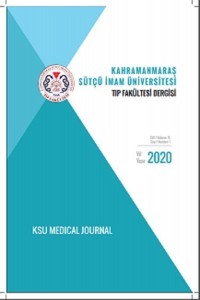Wolfram (DIDMOAD) Sendromu: Olgu Sunumu
Diabetes insipidus, Üriner sistem anomalileri, Wolfram sendromu
Wolfram (DIDMOAD) Syndrome: Case Report
___
- Wolfram DJ. Diabetes mellitus and simple optic atrophy among siblings: A report of four cases. Proc Mayo Clin 1938;13:715- 718.
- Barrett TG, Bundey SE. Wolfram (DIDMOAD) syndrome. J Med Genet 1997;34(10):838-841.
- Hilson JB, Merchant SN, Adams JC, Joseph JT. Wolfram syndrome: a clinicopathologic correlation. Acta Neuropathol. 2009 May 16. Epub ahead of print.
- Hofmann S, Philbrook C, Gerbitz KD, Bauer MF. Wolfram syndrome: Structural and functional analyses of mutant and wildtype wolframin, the WFS1 gene product. Hum Mol Genet 2003;12:2003-2012.
- Zmysłowska A, Borowiec M, Fendler W, Jarosz PS, Myśliwiec M, Szadkowska A et al. The prevalence of Wolfram syndrome in a paediatric population with diabetes. EndokrynologiaPolska 2014:65(4),295–297.
- Barrett T.G, Bundey, S.E, Macleod A.F. Neurodegeneration and diabetes: UK nationwide study of Wolfram (DIDMOAD) syndrome”, Lancet, 1995 2;346 (8988):1458-1463.
- Jayne AL, Lynne AR, Christopher R, Timothy GB. Wolfram Syndrome. Reviews End Met Dis 2003;4:53-59.
- Tekgul S, Oge O, Simsek E, Yordam N, Kendi S. Urological manifestations of the Wolfram syndrome: observations in 14 patients. J Urol 1999;161(2):616–617.
- Cremers CWR, Wijdeveld PGAB, Pinckers AJLG. Juvenile diabetes mellitus, optic atrophy, hearing loss, diabetes insipidus, atonia of the urinary tract and bladder and other abnormalities (Wolfram syndrome). Acta Paediatr Scand Suppl.1977;(264):1-16.
- Hattori H, Inada H, Tanaka K. Auditory brainstem responses (ABR) in patients with Wolfram syndrome. No To Hattatsu 1998;30(5):387-393.
- Rose FC, Fräser GR, Friedmann AI, Kohner EM. The association of juvenile diabetes mellitus and optic atrophy: clinical and genetical aspects. Q J Med 1966;35:385-405.
- Urano F. Wolfram syndrome: diagnosis, management, and treatment. Curr. diabetes Rep. 2016:16(1).
- EI-Shanti H, Lidral AC, Jarrah N, Druhan L, Ajlouni K. Homozygosity mapping identifies an additional locus for Wolfram syndrome on chromosome 4q. Am J Hum Genet 2000;66:1229- 1236.
- Eiberg H, Hansen L, Kjer B, Hansen T, Pedersen , Bille M. et al. Autosomal dominant optic atrophy associated with hearing impairment and impaired glucose regulation caused by a missense mutation in the WFS1 gene. J Med Genet 2006; 43:435- 440.
- ISSN: 1303-6610
- Yayın Aralığı: Yılda 3 Sayı
- Başlangıç: 2004
- Yayıncı: Kahramanmaraş Sütçü İmam Üniversitesi
Tıp Fakültesi Öğrencilerinde ve Aile Hekimlerinde Anemi Bilgi ve Farkındalığının Değerlendirilmesi
Emirhan ÇAKAR, Raziye Şule GÜMÜŞTAKIM, Celal KUŞ
Perinatal Dönemde Ruh Sağlığı Sorunları, Yaygınlığı, Neden ve Sonuçları: Derleme
İnce Barsak Atrezi ve Stenozu Olgularında Sağ Kalımı Etkileyen Faktörler
Selcan TÜRKER ÇOLAK, Murat ALKAN, Recep TUNCER
Serum 25-Hidroksi Vitamin D Düzeyi Siğil Şiddetini Yansıtmaz: Kesitsel Bir Çalışma
Gökşen ERTUĞRUL, Habibullah AKTAŞ
Karaciğer Sirozu Tanısı ile Takip Edilen Konstriktif Perikardit Olgusu
Murat KERKÜTLÜOĞLU, Enes ÇELİK, Bayram ÖZTÜRK, Hakan GÜNEŞ
112 Ambulans Çalışanlarının Hizmet ve Sosyal Durumlarının Değerlendirilmesi
Muhammed Semih GEDİK, Hakan HAKKOYMAZ, Nuri Mehmet BASAN, Yılmaz SAFİ, Erdem AKSAY
Kikuchi-Fujimoto Hastalığı mı, Lenfoma mı?
Sema YILDIRIM, Ayşe AŞIK, Bengü ÇOBANOĞLU ŞİMŞEK, Ayşe BOZKURT
